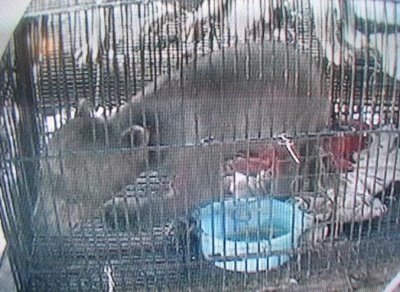Captive sun bear series III: Life in hell
It all begins with an idea.
Sun bears confined in cages for life
If these baby bears can past the crucial infant stage where extensive cares was needed, they could pretty much make it to adulthood without any problem. However, more suffering once they grew bigger and stronger. By a year old, they could reached 15 kg, and were no longer safe pets to their human owners. Their strength grew, together with the tools that they used to find food: claws and canines, which could potentially did a lot of damage, if they wanted to. Depending on where were them kept and who kept them, they could be locked in small metal cages, sometime as small as 1m x 1.5m x 1.5m. In places like mini zoo or private menageries, they were usually kept in slightly larger cages with cement floor. One thing for sure is that these bears will never had a chance to feel soil, use their claws to dig, or their canine to bite (I will write more about how a wild sun bear live in the wild later).
If these baby bears can past the crucial infant stage where extensive cares was needed, they could pretty much make it to adulthood without any problem. However, more suffering once they grew bigger and stronger. By a year old, they could reached 15 kg, and were no longer safe pets to their human owners. Their strength grew, together with the tools that they used to find food: claws and canines, which could potentially did a lot of damage, if they wanted to. Depending on where were them kept and who kept them, they could be locked in small metal cages, sometime as small as 1m x 1.5m x 1.5m. In places like mini zoo or private menageries, they were usually kept in slightly larger cages with cement floor. One thing for sure is that these bears will never had a chance to feel soil, use their claws to dig, or their canine to bite (I will write more about how a wild sun bear live in the wild later).
Most people who live in the countries where sun bears are found have no idea what is animal welfare about. In their dictionary, there is no such terms like “animal rights”, nor “animal welfare.” They do not think that the animals also have feeling, emotion, dignity, and can feel pain like a human being. What most people think about most animals is that they are here to serve us. As a result, bear owners do not feel it is wrong to cage a magnificent wildlife like a sun bear in a small cage. They think that as long as they feed the bear, and the bear stay alive, they are doing a very good job on “TAKING CARE” of the bears.
Sun bears are very “durable” animals. I say so because they can pretty much live on any kind of food once they passed the infant or young cub stage. They can be fed on pure fruit diet or pure rice diet by the owners or animal keepers who do not have a clue on nutritional or balance diet for a carnivore like sun bear. They will feed them whatever is the cheapest, easiest to obtain, and simplest for their job: “taking care” of bears! Most people will never feed these bear any meat product because they think by doing so the bear will become a “man eater” or be very dangerous. Yet, most captive bears are over fed, they are obese, and look being well “taken care” of.
Local tourists who visited the menageries, mini zoos, crocodile farms, or even zoos, do not think that it s wrong to keep the bears in such poor condition. Almost no one will feel sympathy for the bears being raised in such a poor condition. In stead, they think that the bears were quite funny, quite amusing, and fun to watch, especially these bears may stand up right to beg food from visitors. No one complains about the bears have small room to roam, hot under baking tropical sun, etc. At the end, these bears continue their suffering, no one concern about their welfare.
Captive sun bear series II:
It all begins with an idea.
Life at young in captivity, then suffering begin.
Life in hell for cute sun bear cubs
Because they are small and cute, sun bear owner often keep them in a small pet cage for puppies or birds. This is the beginning of life in hell.
I once saw a bear cub in a crocodile farm in Sarawak. From a distant he looked like a puppy because she was place next to a puppy. But from my distance, she did not look like a puppy because she paced none stopped. Puppy rarely paced, but sun bear pace all the time in captivity. Her condition was a typical bear cub in captivity: malnutrition with very pale color coat, weak, dehydration, stress, and extremely nervous. I immediately put my finger into her month to let her suckle.
Sun bear cub suckle to seek comfort. It is the same reason as babies like to suck pacifier. If their mother is around, they of course nurse from their mother’s nipples, even until they reach adulthood. I once saw an adult sun bear in Singapore Zoo do that even when he was an adult.
Solitary captive bears suck on pretty much any body part that they can get hold of: hand, feet, even their own penis, vulva, or other bears’ ears, if they have a companion to stay with. They will admit a series of “ummmmmmm..” sound with their eyes half closed when suckle. This is pretty much the first thing I do when I approached a nervous captive bear cubs, let them suckle, they then will calm down quickly and slowly trusting me.
Like other animals, infant sun bears are very fragile creatures that need lots of care, attention, and nutrition. In captivity under human care, they usually receive very little of these essential elements, not to mention TLC that their mother use to give them.
Unknown number of cubs died due to improper care, simply because of these so call bear owners do not have a clue how to take care and what to feed to baby bears. Many of them were given sweet condense milk, high fruity diet like lots of papaya and banana because they are cheap. Because of imbalance diet, many sun bear babies in captivities show signs of malnutrition and unhealthy. They did not have sleek black coat, but in stead, their hairs are sparse, dull, and pale color. Many of the cubs that looks like this will not live long.
In Indonesia or Thailand, high government officials often keep bears or other wildlife to simply show off their power and status. In other region, rich people buy those cubs to amuse them. However, bears are carnivores, no matter how cute and how tame they are when young, they will eventually turn into a dangerous beast no matter what given a year or two. They are well equipped with the tools to harm their owner or anyone who are less lucky. Sometime these casualties maybe not be an intentional attack or predatory behavior, they are simply the beasts that can cause serious injuries to human during bear play fights. This is what they are after all!
(Notes: it was uneasy for me when I posted this piece after searching through my old photo files of these sun bears cubs. Looking at the photos and video clips of these babies were absolutely heart broken! They brought me to the actual scene when I found these babies.)
Captive sun bears series I: Because they are cute!
It all begins with an idea.
Sun bear cubs are sold as pets!
Sorry for the long silent. Life in the field is surly hectic with challenges but too few people to help up.
To get the momentum of this blog start again, I reposting a series of stories about captive sun bears from my original blog
====================================================
Its all started here: sun bear cubs are cute, they are so cute and adorable, way from any body’s imagination. If you think puppies are cute or kittens are cute or baby orangutans are cute or human babies are cute, think again after you see a sun bear cub!
And also because sun bears are the smallest bears in the world and so cute, they make a perfect pet (well, I do not think so). This is where it all started: Sun bear cubs are being captured and sell as pets after poachers killed their mother for profit. Bear meat, paws, claws, canines, gallbladder, bear hide, you name it, all have a price tag and people willing to pay good money for bear products.
Back in 2000, a friend who visited me in Danum where I did my first sun bear ecology study told me that he saw some one trying to sell a small sun bear cub at Gaya Street Pasar Tamu, Kota Kinabalu’s famous Sunday market, just few days ago. The cub was priced at few hundred ringgit. Beside this poor cub was her mother, chopped into pieces, sell for meat. I was in complete stunned and don’t know what to say.
Of each of the cute sun bear we see in captivity, there is a heartbreaking story to tell that we do not see. Yes, they are so cute. But no, they are so sad.
















